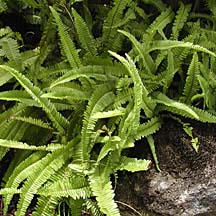
In the Garden![]()
Michael Miyashiro
Kupukupu fern
LATIN NAME
Nephrolepis cordifolia
Description: A type of sword fern with erect fronds measuring 1 to 2 feet tall and 2 to 3 inches wide. Each frond comprises many smaller pinnae (frondlets), each about 1 to 1 1/2 inches long. Generally, these ferns are terrestrial, meaning that their stolons (sprawling stems of ferns, which look like roots) spread out across the surface of the dirt. Occasionally they will be epiphytic, crawling up trees or tree ferns.
The most distinguishing characteristic of this fern is that it is the only species of Nephrolepis in Hawaii to have underground tubers that develop on the stolons, which offer a means to store food, as well as a reproductive system from which new ferns develop.
HUI KU MAOLI OLA
The Kupukupu fern's ability to climb and sprout symbolizes growth and knowledge.
Distribution: This indigenous fern is found throughout the tropics and is a common fern in cultivation. It is fairly common on all Hawaii's main islands in mesic (somewhat wet), to wet forests.
Cultural use: It was often used to decorate hula altars, symbolizing a place of learning or sprouting knowledge. The word "kupu" means "to sprout." The fronds also are used for making lei.
Landscape use and care: Plant kupukupu in full sun or partial shade. It looks great as an accent plant around landscapes or pohaku (stones) or planted as a mass ground cover. However, do not plant them too close together, at less than 18 inches apart. This is because they can out-compete each other and eventually die back in a short period.
Plant them at the base of a rock wall and they will slowly crawl upward, sprouting new ferns in crevices. Daily watering is fine as long as the plants are in well-drained soil. Don't allow the fern to sit in standing water or it will start to turn yellow and defoliate, often resulting in its demise.
Also: There are at least five species of Nephrolepis found here in the wild. Of these, only two are native: the one described here and another larger species named Nephrolepis exaltata subsp. hawaiiensis, which is an endemic subspecies. The other three are naturalized alien species that can be very invasive. The problem with this is that they can and often will hybridize with the native species, jeopardizing their genetic integrity.
Rick Barboza co-owns Hui Ku Maoli Ola, a Native Hawaiian plant nursery, with Matt Schirman. Contact him at 259-6580 or e-mail rickckbarboza@aol.com.
Gardening Calendar


